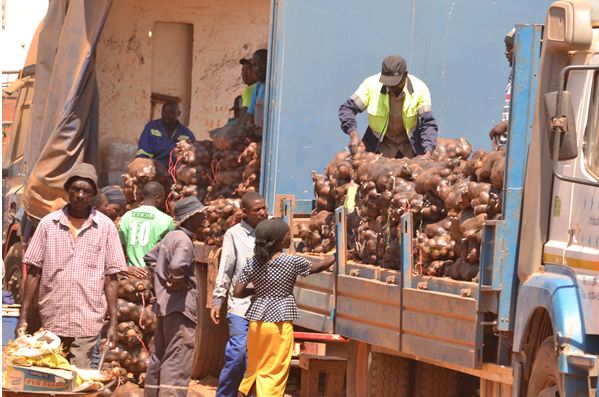The seasonal nature of most African food systems implies there are times when indigenous fruits, tubers, tomatoes and other commodities ripen at once. This presence challenges in harvesting and storing these commodities in ways that extend shelf life and preserve nutritional elements. When indigenous fruits are in season, they are too abundant such that very few communities have the capacity to handle gluts. It is under these circumstances that bridging finance can enable entrepreneurs to buy these commodities when they are in season and store in warehouses for later value addition when the commodities become out of season.

Using bridging finance to respond to demand
As the name suggests, bridging finance is finance that bridges gaps between seasons and needs of farmers. When the market is very slow in absorbing commodities that continue to ripen fast and furiously, bridging finance can be availed to farmers so that they continue working on the farm rather than waiting for all their commodities to be bought before taking the next step. In most cases, when traders buy potatoes, tubers and other bulky commodities from farmers, funds are locked in the bought stock such that until the stock is sold, the traders will not have extra funds to go and procure more commodities that are fast ripening in farming communities. This also means farmers are stuck with the commodity until the traders return to buy.
Meanwhile, the farmers will also be incurring losses because when commodities have ripened, they have ripened and want to be consumed. If traders have access to bridging finance, they can buy all the ripening commodities from the farmers and store in warehouses then sell slowly as the market demand picks up. Absence of bridging finance also prevents traders from taking advantage of spikes in commodity demand often triggered by specific periods such as holidays or the festive season that are often associated with high demand for particular commodities. Access to flexible bridging finance can enable traders to hoard more commodities in order to satisfy sudden demand during Christmas periods and other holidays that trigger huge consumption patterns.
Absence of bridging finance causes price fluctuations
Whereas bridging finance can enable consistent availability of commodities in the market since traders would be able to buy commodities as they ripen, absence of bridging finance causes inconsistent procurement of commodities which leads to price fluctuations. Farmers, traders and consumers cannot properly plan when prices are always fluctuating due to inconsistent availability of commodities in the market. Farmers will not go to the next cycle of harvesting until the traders have paid for commodities. Instead of building lasting relationships with particular buyers, farmers end up dealing with whoever comes to buy and that increases speculative behaviour.
Lessons from the potato value chain in Zimbabwe
More than 70 percent of the potato value chain in Zimbabwe is in the hands of self-organized market traders who creatively combine potato marketing with providing bridging finance to different levels of potato farmers. Working mainly from Coca Cola market site in Harare, the traders have organized themselves into a Potato Traders Association comprising 62 members. These are big pushers who sell more than 800 metric tons of potatoes a day. Over the years, the traders have built a strong relationship with farmers, enabling them to pre-finance the production of potatoes by providing inputs and funds for wages among other needs. A win-win partnership arrangement has been built under which traders provide finance while farmers provide land, labour and supervisory expertise.
Before the traders inserted themselves into the value chain, potato production was a preserve of large-scale farmers who were the only ones able to invest more than USD12000 00/hectare in order to break even. Traders have proved that it is possible to bring smallholder farmers into potato production as long as they have the right land, micro climate and other requirements. The traders are working with a wide range of farmers from those producing on two hectares to those farming more than 500 hectares. This has turned potato into an inclusive rather than exclusive value chain. Farmers and traders walk the journey together from planting to marketing with both sides sharing risks and benefits equally. At marketing stage, the cost of production is subtracted first before both sides share the profit. Price information is so transparent that everybody knows the prices of different potato grades.
Relationships are the most important form of collateral
The way potato traders work with farmers has challenged formal financial institutions like banks to rethink their models including the notion of collateral which they tend to value more than relationships. The traders sponsor commodities they are able to market and farmers feel more comfortable because they do not have to deal with the marketing headache. More importantly, traders are more responsive to the time-sensitive nature of potato production than formal financial institutions that can spend weeks pushing papers while time for planting is moving. Based on their thorough understanding of the marketing season and demand patterns, traders are so flexible that they can even avail bridging finance during weekends rather than keep the farmer waiting for cash until Monday.
Farmers requiring bridging finance simply provide a budget to the traders up to 120 days covering wages, chemicals, top dressing, labour and all the stages until the crop is ready for harvesting. On harvesting day, they also agree on the market- either open market or formal market. In the words of Godfrey Majeje, Chairperson of the Potato Traders Association: “When relationships and agreements are strong and secured through lawyers, there is no need for farmers to pledge their tractors or cattle in order to get bridging finance from traders. In any case, those are the very assets that farmers are using to produce and attaching those assets will weaken the partnership. In the event of a drought or anything going wrong, the farmer and the trader re-start to recover the costs and continue with the partnership through thick and thin. That is how we do business.”
Taking the momentum beyond potatoes
Riding on successes of the potato value chain, the traders are now taking the model to other commodities like grains, cabbages, tubers and butternuts which are also now being pre-financed by traders. Farmers with small volumes of grains often find it uneconomic to take those commodities to distant markets and to solve this problem, traders move around farming communities buying grains and other commodities. Farmers are given cash which they need to solve immediate challenges rather than travelling to the bank in the city. These partnerships between traders and farmers are now increasing in horticulture where production is rarely financed by formal banks. All this confirms that collaborative knowledge is stronger than siloed expertise in the heads of agronomists and bankers. A web of interdependent perspectives between farmers, traders, transporters and consumers can generate more practical solutions that ‘experts’ working in ivory towers.
Charles@knowledgetransafrica.com / charles@emkambo.co.zw /
Website: www.emkambo.co.zw / www.knowledgetransafrica.com
Mobile: 0772 137 717/ 0774 430 309/0712737430
